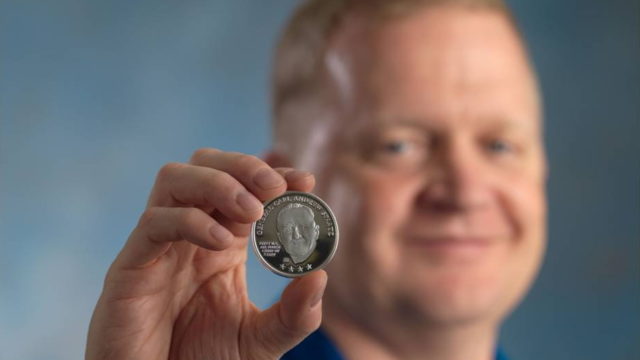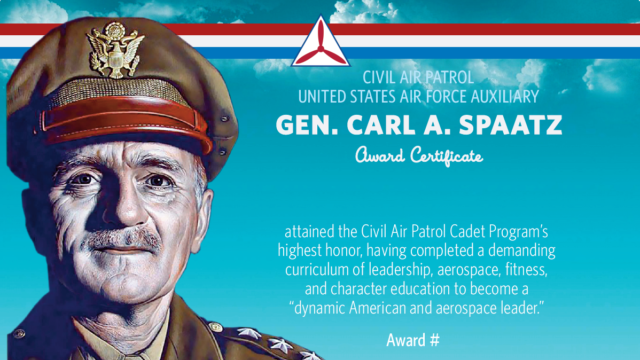Presenting the Award
Since 1964, the CAP Cadet Program has served as a successful blueprint for the development of generations of aerospace leaders.
The history and heritage of the Cadet Program is rich with tradition. In its earliest iteration, a special awards ceremony for the presentation of each Cadet Program achievement (Phases I and II) and the two benchmark awards (Mitchell and Earhart Awards) was prescribed. The original CAPM 50-3, The Leadership Laboratory Manual, described these award ceremonies in exacting detail.
In addition to a ceremonial formation, the prescribed guidance included the reading of a citation consisting of a standard prelude, an interlude, a eulogy, and a benediction. Each reading was themed to the aviation leader memorialized by the award to be presented.
For years, members of The Spaatz Association noted that there was not a similar citation to accompany the General Carl A. Spaatz Award. Perhaps this omission was due to the fact that the Spaatz Award was not typically awarded at unit level.
Nevertheless, this omission presented an opportunity to build on an enduring tradition through the development of an appropriate citation and guidelines for the presentation of the General Carl A. Spaatz Award.
To bring this tradition to life, Brig. Gen. Richard L. Anderson, CAP (Spaatz award # 193) prepared a citation for use at future Spaatz Award ceremonies. The language and structure is based on his careful study of the original Cadet Program citations, and endorsed for use with the CAP Cadet Program by General Spaatz’s family.
The Spaatz Association is proud to make these guidelines available here. Cadets and Cadet Program Leaders are encouraged to use these guidelines when they recognize new Spaatz cadets.
The General Carl A. Spaatz Award
PRESENTATION CEREMONY
Approved by: The Family of General Carl A. Spaatz, and The Spaatz Association, Inc.
General Information
The highest Cadet Program award is the General Carl A. Spaatz Award and with it promotion to the rank of Cadet Colonel. CAPR 52-16 (2-10.e) prescribes that “A military or CAP General Officer, governor, congressman, federal judge, or a cabinet-level official presents this award.”
- Participants:
- Cadet to be awarded
- Emcee: the person presiding over the “umbrella” event at which the award will be presented. Introduces the Spaatz Award portion of the event, the narrator, presenter and Cadet(s) involved.
- A narrator(s) to read the Spaatz Award citation
- A presenter of suitable rank or stature (see above) to present the award.
- Award Elements:
- General Carl A. Spaatz Award certificate and ribbon, provided by CAP NHQ
- General Carl A. Spaatz challenge coin and gift case, engraved with the Cadet’s Spaatz award number, available through The Spaatz Association.
- Venue:
- A venue appropriate to the capstone stature of this award.
- An national or regional dinner and/or awards event sponsored by The Spaatz Association and attended by TSA Officers
- A National or Regional Civil Air Patrol convention attended by National Board Members and other CAP dignitaries.
- Other location of noteworthy significance, such as the White House, Supreme Court, Pentagon, a Congressional or Governor’s Office.
- Military Headquarters of significance, such as the Pentagon, a major command or installation.
- If at a formal military review then the roles for those attending are prescribed in appropriate “Drill and Ceremonies” guidance. The reading of the citation should be incorporated, as appropriate.
- A venue appropriate to the capstone stature of this award.
- Publicity:
- A dedicated photographer to produce quality pictures of the presentation
- A PAO (or similar) to prepare an article on the award, including the venue and a brief bio of the presenter and the Cadet.
- The article and picture(s) should be disseminated widely including the Spaatz Association website; CAP Volunteer magazine, the Cadet’s hometown newspaper(s), etc.
The Ceremony – Sequence of Events
- Emcee:
- Announces The Spaatz Award portion of the overall event.
- Introduces the Narrator for the citation and the Presenter of the Award; give a brief biographical sketch of each.
- Introduces the Cadet(s) to receive the Award; gives a brief biographical sketch of each.
- Turns proceedings over to Narrator(s)
- Narrator(s):
- There may be several narrators to read different portions of the citation, depending on circumstances.
- The Narrator assumes the podium with the Presenter and the Cadet standing behind and to the left of the Narrator.
- The Narrator(s) reads the Prelude, Interlude, Eulogy and Benediction. If one Narrator is reading, then with a short, respectful pause between each portion of the citation.
- On completion of the Benediction the Narrator states:
Narrator: “The recipient(s) of the Spaatz award is (are); ___ (then announces the last name, first name and new grade of each Cadet to receive the Spaatz Award).”
Presenter and Cadet then face each other. They exchange salutes, if appropriate. The certificate is exchanged with the left hands while the right hands are shaken. After a pause for pictures, the Cadet and Presenter again face each other, exchange salutes (if appropriate) and depart the stage.
Presenter: “This concludes our presentation(s) of the General Carl A Spaatz award(s).” Then returns the proceedings to the Emcee.
Prelude
We are members of Civil Air Patrol. We stand in the shadow of a long line of American heroes who served as Minutemen of the air — Gill Robb Wilson, Hap Arnold, Tooey Spaatz, and many others who fanned the flame of volunteer service to our Nation.
Membership in Civil Air Patrol demands dedication to the principles of freedom and aggressive action to sustain our Nation’s Aerospace supremacy. We do still more. We assist in providing emergency services, we foster the development of Aerospace Education, and we are the foundation of the Civil Air Patrol Cadet Program. We dedicate ourselves to the sustenance of Aerospace power. We dedicate ourselves to the principles of aerospace leadership, and we set an example for all Americans to follow in a world dominated by air and space vehicles. We dedicate ourselves to the continued progress of our community, state, and nation.
Interlude
The Civil Air Patrol cadets assembled here are to be honored for attaining significant achievements in the CAP Cadet Program.
We may reasonably ask what they have accomplished to be recognized in the name of General Carl A. “Tooey” Spaatz, the man from Boyertown, Pennsylvania, who went on to be the first Chief of Staff of the United States Air Force and the first Chairman of the National Board of the Civil Air Patrol. The answer is complex. These dynamic Americans and aerospace leaders have completed all phases of the CAP Cadet Program. They have mastered a comprehensive program of instruction in aerospace education. They have developed increasingly complex leadership skills in a rigorous leadership laboratory. They have maintained commendable examples of good moral leadership in their daily lives, and they have attained high standards of individual performance in a dynamic physical fitness program. And, they have successfully completed the comprehensive General Carl A. Spaatz Qualifying Examination that less than one percent of all Civil Air Patrol cadets have ever completed since the award’s inception in 1964.
Their achievements have equipped them with the spirit of leadership that was characteristic of General Tooey Spaatz. They are alert, enthusiastic, keen of mind, tenacious—outstanding examples of young America. Their achievements offer a tribute to the memory of Tooey Spaatz, and these same accomplishments provide personal monuments that will serve as vital checkpoints in their flight through life.
Eulogy
General Tooey Spaatz was a man of firsts. The first to conduct America’s grand experiment in aerial refueling as a crew member of the famous flight of The Question Mark in 1928. The first to lead US Strategic Air Forces in Europe to Allied aerial victory over Nazi Germany in 1945. The first to serve as Chief of Staff of the post-World War II United States Air Force. And the first to serve as Chairman of the National Board of the Civil Air Patrol. General Spaatz devoted a full military career to establishing the United States Air Force as a separate and distinct military service that stood alongside America’s Army and Navy in defending freedom in both war and peace. After his retirement from active service in 1948, he continued his long career of public service as the first Chairman of the National Board of the Civil Air Patrol, devoting the first decade of his retired life to nurturing America’s Air Force Auxiliary in the same way he had nurtured the fledgling United States Air Force. For all time, Airmen everywhere will remember General Tooey Spaatz as a man of courage, vision, and dedication—as one who shunned the spotlight of celebrity—as one who served without fanfare as a quiet, capable, competent architect of American airpower. Today, America’s military might in the air—and beyond to the far reaches of outer space—is directly attributable to the fortitude, vision, and dedication of this humble man from Boyertown.
Benediction
So long as this is a free man’s world somebody has to lead;
Somebody has to carry the ball in word and thought and deed;
Somebody’s got to knock on doors which never have known a key;
Somebody’s got to see the things that the throng would never see.
Hotter than thrust when the boost is hit, somebody’s faith must burn;
And faster than mach when the rocket’s lit, somebody’s mind must turn;
Somebody’s got to get the proof for what the designers plan;
And test the dreams that the prophets dream in behalf of their fellow man.
Somebody’s got to think of pay in terms that are more than gold;
And somebody has to spend himself to buy what the heavens hold;
Somebody’s got to leave the crowd and walk with his fears alone;
Somebody’s got to accept the thorns and weave for himself a crown.
It’s ever thus as the ages roll and the record’s written clear—
Somebody has to give himself as the price of each frontier;
Somebody has to take a cross and climb to a rendezvous,
Where a lonesome man with a will to lead can make the truth shine through.—Gill Robb Wilson

